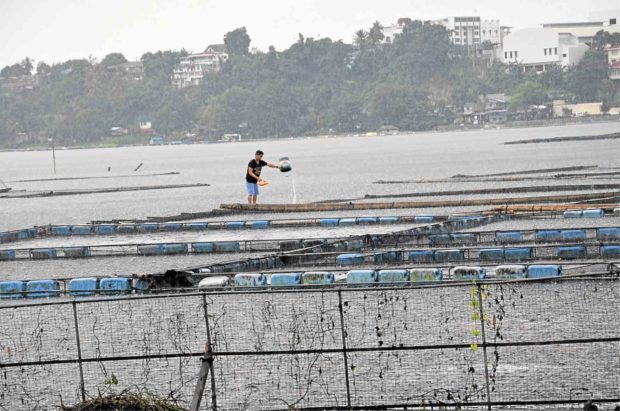
A worker feeds fish cultured in cages in Sampaloc Lake in San Pablo City, Laguna. —CONTRIBUTED PHOTO
SAN PABLO CITY — The government is now targeting to dismantle illegal fish cages in Sampaloc Lake, one of this city’s popular seven interconnected lakes and a major tourist attraction in Laguna province.
The Laguna Lake Development Authority (LLDA), which has jurisdiction over the Laguna de Bay region, issued a new set of guidelines that essentially reduces the aquaculture area in the 102.66-hectare Sampaloc Lake.
Under the new zoning map, fish cages scattered on the surface water would be lumped into clusters only in the lake’s northern and eastern portions.
Each fish cage would be limited to a maximum size of 600 square meters, reducing the total aquaculture area of 98,600 sq m to only 96,000 sq m. The Fisheries Code only allows 10 to 12 percent of a lake’s surface water for fishing structures.
The new memorandum circular presented by LLDA general manager Jaime Medina and Mayor Loreto Amante last week was a revision of the 1998 LLDA board resolution on Sampaloc Lake.
Medina, who was appointed to head the LLDA in January, admitted to the agency’s failure to regulate Sampaloc’s aquaculture over the years, resulting in illegal fish cage operations and the lake’s deterioration.
In 2014, the international foundation Global Nature Fund named Sampaloc Lake the year’s “threatened lake,” primarily because of the tilapia fish cages cluttering the water.
“I myself feel ashamed. How come it took this long?” Medina said in a press briefing here.
Both the city government and the LLDA could not say how much the Sampaloc Lake yielded, citing poor documentation in the past.
Mixed-use dev’t
Jun Paul Mistica, LLDA project development management and evaluation division chief, said that aside from reducing fish cages in Sampaloc, the agency would also monitor the use of fish feed that eventually pollute the water and introduce a “uniform” type of materials for constructing the cages.
Donnalyn Briñas, city tourism officer, said the local government would offer livelihood training to those who might be displaced by the new regulations.
Sampaloc Lake is Laguna’s second most popular attraction next to Sta. Rosa City, according to the provincial government.
The 3.7-kilometer lake circumference, where biking activities and several food stalls are available, drew 332,508 visitors in 2016.
Major transformations were seen after the city government relocated over 400 families of illegal settlers who used to discharge household wastes directly into the water.
Mistica said they were promoting the mixed-use development of Sampaloc Lake to allow ecotourism.
“But the bottom line is still environmental protection,” he said.
The LLDA has been leading massive demolitions of fish pens in the 90,000-ha Laguna de Bay on orders of President Duterte to rehabilitate the Laguna de Bay region.
The agency is developing management plans for the six other lakes of San Pablo—Pandin, Yambo, Muhicap, Palakpakin, Calibato and Bunot.